Dark predictions of the future from climate alarmists warn that “climate change” will force hundreds of millions of “climate migrants” to flee from hellish conditions caused by humanity’s use of fossil fuels and its resulting CO2 production. (Those who are not quite as bold in their conviction might call it “climate-encouraged migration”.) A widely-cited 2008 report by the Intergovernmental Panel on Climate Change (IPCC) suggested 200 million migrants could be displaced by 2050. The question that naturally follows is, “What specific effects of ‘climate change’ would drive this migration?” The IPCC cites rising sea-levels, agricultural land that has been salinized and desertified, and most importantly, water scarcity and food insecurity, which frequently go hand-in-hand. Indeed, severe food scarcity has driven populations to move in the past.
If we ignore non-agricultural variables such as food imports and food distribution, then food scarcity is clearly a result of low agricultural production, which can be blamed on a number of possible factors, including poor soil quality, ignorance of modern scientific farming, diseases and pests, and environmental conditions, e.g., variations in temperature and precipitation or irrigation.
The bottom-line measure of agricultural efficiency that directly depends on soil quality, farming methods, (prevention of) diseases and pests, and growing conditions is crop-yield. Crop yield is essentially the ratio of crop production per unit of land area, usually measured in metric tons per hectare or hectograms per hectare. To understand if there is potential for climate-linked migration due to food-scarcity, crop yields provide a reasonable test. Because good climate conditions are a necessary prerequisite, but not a sufficient condition, for high yields, uniformly high yields of important crops that are well-sampled geographically can effectively rule out climate-related drivers of food scarcity.
The Food and Agriculture Organization of the United Nations (often called the FAO for short) has kept reliable statistics on cultivation area, production, and yield for various crops, by country, from as far back as 1961. These statistics can be easily found in the FAO’s database.
The graphs displayed below show the historic crop yields, with trend lines, for important crops from a representative set of countries that could be affected by “climate change”. Included are the historic yields of maize (corn) in Mexico, rice in India, coffee beans in Brazil and in Vietnam, sweet potatoes in Kenya, and bananas in Guatemala. You want to see the real "green movement"? This is it:
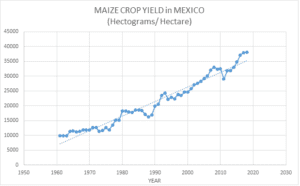
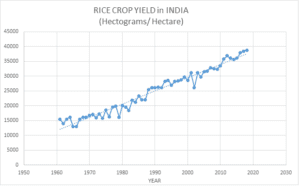
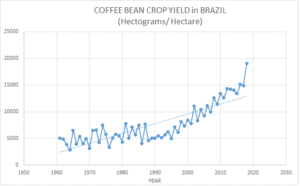
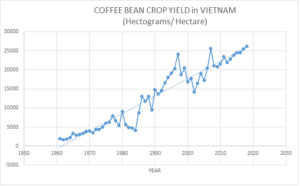
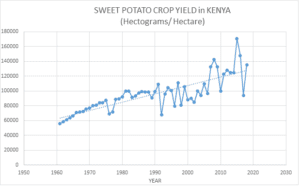
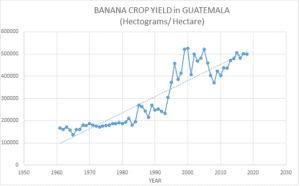
These positive yield trends are not outliers, but rather, they are typical of other crops around the world. The devil’s counterargument is that these excellent results were brought to us by scientific farming, but the counter-counterargument is, science would be irrelevant if the most important variable – climate – were not sustaining of agricultural production.
Even if we assume the climate is warming overall, the production of food crops may not be significantly impacted. According to a study on the causes of crop failure, by Yale researcher Robert Mendelsohn, annual warming may have little to do with crop failures:
Warmer average temperatures in January and April contribute to higher crop failures whereas warmer October temperatures reduce failure rates. October temperatures are a proxy for autumn harvesting conditions. Warmer temperatures in this period help to dry at least grain crops. They may also extend the growing season allowing crops to fully mature. Curiously, July temperature does not have a significant effect. Although the seasonal temperatures have a significant effect on crop failure rates, they are offsetting. Adding the effects of the three seasons together suggest that annual warming will not have a significant effect on crop failure rates.
Furthermore, nothing in the FAO’s crop yield statistics gives an indication that the trend of increasing yields will not continue for the foreseeable future. Michael Shellenberger recently summarized the FAO’s long term projections in Forbes:
Humans today produce enough food for 10 billion people, or 25% more than we need, and scientific bodies predict increases in that share, not declines. The United Nations Food and Agriculture Organization (FAO) forecasts crop yields increasing 30% by 2050. And the poorest parts of the world, like sub-Saharan Africa, are expected to see increases of 80 to 90%.
He goes on to remind us that the FAO cites basic concerns, not climate, as critical to continued growth in yields:
Rates of future yield growth depend far more on whether poor nations get access to tractors, irrigation, and fertilizer than on climate change, says FAO.
If the world were on fire, as the alarmists assert, would our fields be so lush and bountiful? While it is quite possible that many people will choose to move from warmer, less developed parts of the world to cooler, more-developed ones, in the future, it almost certainly would not be because agriculture collapsed from an inhospitable Earth.
Article tags: climate change, climate migrants, Environment, environmentalism, global warming, Green Movement, IPCC, United Nations
[…] During Medieval Warm Period Than Today Study: Strongest warming in 10,000 years by the Sun not CO2 Why Would ‘Climate Migrants’ Flee from Food? COVID-19 Could Help Solve Climate Riddles UN climate fund calls pandemic an ‘opportunity’ to […]
[…] The Scientific Case for Vacating the EPA’s Endangerment Finding US CO2 Emissions Have Declined More Than Anywhere Else Study: It Was Warmer In China During Medieval Warm Period Than Today Study: Strongest warming in 10,000 years by the Sun not CO2 Why Would ‘Climate Migrants’ Flee from Food? […]
[…] During Medieval Warm Period Than TodayStudy: Strongest warming in 10,000 years by the Sun not CO2Why Would ‘Climate Migrants’ Flee from Food?COVID-19 Could Help Solve Climate RiddlesUN climate fund calls pandemic an ‘opportunity’ […]